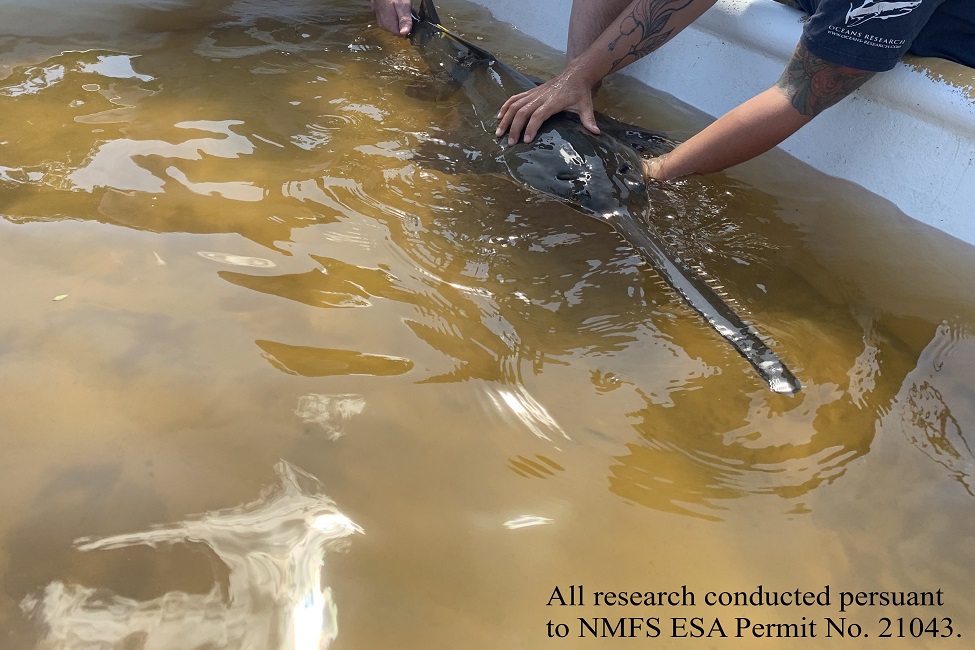Endangered Juvenile Smalltooth Sawfish Found in St. Lucie River

The female smalltooth sawfish measured 155 centimeters long (approximately 5 feet), including the saw. Based on this length, researchers confirmed that the immature animal was approximately 1 year old. (Photo credit: Florida Fish and Wildlife Conservation Commission)
Capable of growing up to about 16 feet long, the elusive smalltooth sawfish (Pristis pectinata) is easily identified by its large, toothed rostrum or “saw.” It is one of five sawfish species worldwide, and the only sawfish species found in Florida waters. Historically found along the east coast of the United States and throughout the Gulf of Mexico, this species commonly inhabited Florida’s east and west coasts, including the Indian River Lagoon (IRL). Unfortunately, their population has drastically declined and they are currently listed as endangered under the U.S. Endangered Species Act.
In mid-September, researchers from Florida Atlantic University’s Harbor Branch Oceanographic Institute responded to a report of a juvenile smalltooth sawfish that had been caught by Florida Fish and Wildlife Conservation Commission (FWC) biologists while conducting their monthly fishery-independent monitoring sampling in the St. Lucie River. Matt Ajemian, Ph.D., an assistant research professor at FAU’s Harbor Branch and head of the Fisheries Ecology and Conservation (FEC) Lab, was contacted by the FWC team and sent Mike McCallister, research coordinator at FAU’s Harbor Branch, to assist in tagging the rare sawfish.
The female smalltooth sawfish measured 155 centimeters long (approximately 5 feet), including the saw. Based on this length, researchers confirmed that the immature animal was approximately 1 year old. They took a small fin-clip to perform DNA analyses, surgically implanted a 10-year acoustic transmitter, and affixed an external ID tag to a dorsal fin.
“The acoustic tag we placed in the young sawfish will allow us to track its movements with acoustic receivers that already exist throughout the St. Lucie River and Indian River Lagoon, which are part of the Florida Atlantic Coast Telemetry [FACT] Network,” said McCallister. “The external tag will help us to quickly identify this animal if it is caught again. It actually was caught by an angler and reported to the Sawfish Hotline the very next day.”
In total, this is the seventh sawfish caught in the IRL system since 2016, and the fourth to be acoustically tagged by Ajemian’s research team in collaboration with FWC researchers. The team has previously caught and tagged larger, adult sawfish near the mouth of the St. Lucie Inlet and near the Florida Power & Light (FPL) power plant.
“The ability of FWC staff to quickly connect with Harbor Branch staff and set in motion the process of tagging the sawfish was due in large part to their mutual membership in the FACT Network,” said Joy Young, Ph.D., a biologist with FWC and data manager for FACT. “The FACT Network is a community, promoting scientists working together for the betterment of scientific discovery even when not working on the same project or from the same institution. Due to the standing relationship between FACT members, we will know more about the movements of sawfish in the St. Lucie estuary.”
To date, this is the furthest up the St. Lucie River they have ever caught a sawfish and based on habitat use patterns documented elsewhere in Florida, it may remain in the IRL for at least another year or two. This latest endeavor by FAU’s FEC Lab and FWC biologists marks a significant step for sawfish research and recovery efforts in Florida.
“In recent years, we’ve received a fair number of reports of large smalltooth sawfish through the Sawfish Hotline, especially adults in the coastal ocean nearby,” said Gregg Poulakis, Ph.D., a biologist who leads the FWC sawfish research team based in Port Charlotte. “However, this year, reports of small juveniles within the St. Lucie River estuary started coming in. To get one that is only 1 year old tagged with a 10-year acoustic tag is a huge milestone. We’re very interested in documenting where this fish goes over the next decade.”
Ajemian’s team in the FEC Lab uses cutting-edge tools to provide the best available science to resource managers, the scientific community, and the general public concerning theoretical, ecological, and applied fisheries and conservation issues. This work involves myriad species including finfish, elasmobranchs (sharks and rays), and shellfish.
“I’m hoping our recent successes in the Indian River Lagoon are indicative of a sawfish rebound in this estuary of national significance, which has been plagued by so many stressors in recent decades. Our partnerships with FWC and other great collaborating organizations give us the crucial capacity to tell where these mysterious and endangered fish are headed in the future,” said Ajemian.
For more information on FAU’s FEC Lab visit www.fisheco.org/. For more information about ongoing sawfish research and recovery efforts in Florida, visit FWC Sawfish and the sawfish recovery webpage www.sawfishrecovery.org. To report sawfish sightings, please call the Sawfish Hotline: 1-844-4SAWFISH or email sawfish@myfwc.com.
All research was conducted pursuant to National Marine Fisheries Service Endangered Species Act Permit No. 21043 and FWC Special Activity License SAL-20-1785-SRP. This research is supported by funding from NOAA-NMFS Species Recovery Grants to States (Section 6 Program).
-FAU-
Tags: harbor branch | science | technology | research | faculty and staff